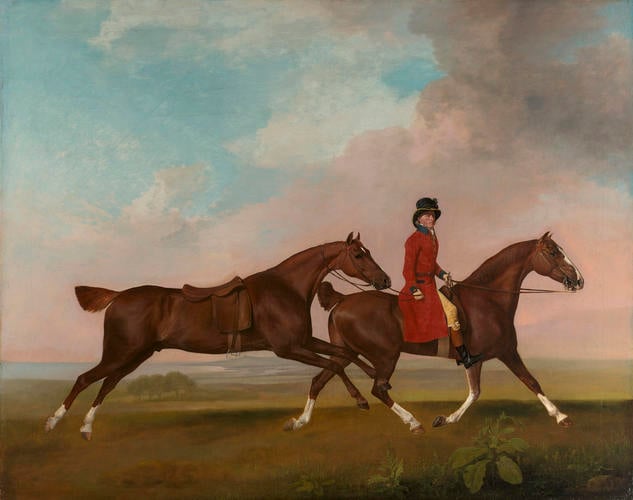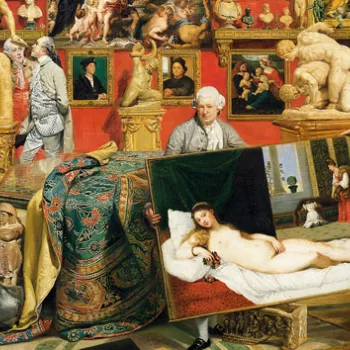William Anderson with two Saddle-Horses Signed and dated 1793
Oil on canvas | 102.3 x 128.2 cm (support, canvas/panel/stretcher external) | RCIN 400106

George Stubbs (1724-1806)
William Anderson with two Saddle-Horses Signed and dated 1793
-
The Royal Collection holds an important group of paintings by George Stubbs; all of them were acquired by George IV when Prince of Wales and all of them (with the exception of OM 1115, 400512) were sent in 1822 from Carlton House to the King’s Lodge (later Royal Lodge) in Windsor Great Park, presumably as an appropriate setting for sporting paintings.
In 1793 Thomas Allwood presented a bill to the Prince for £110 16s, for ‘Carving & Gilding eight Picture frames of half length size [40 x 50 inches] for sundry Pictures painted by Mr Stubbs’. This is one of thirteen paintings in the collection of these dimensions (40 x 50 inches), all in identical frames and all dated between 1790 and 1793 (OM 1109-12, 1115-8, 1122-6, 400142, 400106, 400995, 400997, 400512, 400560, 400994, 400587, 400510, 400562, 400943, 405001, 400549). It is not possible to say which were the eight mentioned in Allwood’s bill, and how they might have been grouped or paired off; but they all seem to have been conceived loosely as a set.
A well-stocked mews provided a nobleman with a ‘string’ of horses (like a relay race) for a hunt or ride. A fresh horse is here brought along by the Prince of Wales’s Head Groom, ready for when the Prince’s current mount tires. We must imagine the Prince himself to be riding a few yards ahead, just outside Stubbs’s field of vision.
On 25 September 1780 the great potter, Josiah Wedgwood (1730-95), wrote to his friend Thomas Bentley (1730-80), ‘I find Mr. S. [Stubbs] repents much his having established this character for himself. I mean that of horse painter, & wishes to be considered as an history and portrait painter.’ The problem was that Stubbs patrons admired him in his former capacity. When he proposed a design for a Wedgwood ceramic plaque of the Fall of Phaeton (now in the Lady Lever Art Gallery, Port Sunlight), the latter wrote, ‘I have objected to this subject as a companion to the frightened horse as that is a piece of natural history, this is a piece of un-natural fiction’. (Wedgwood to Bentley, 28 October, 1780). Something about Stubbs’s close observation, careful outlines and smooth surfaces suggests that he is less able to make the transition to ‘un-natural fiction’, than his contemporaries, such as Gainsborough. Stubbs has always struck viewers as a natural historian, a matter-of-fact painter.
Stubbs had studied the anatomy of the horse with as much science as any veterinary surgeon of the day. These horses are clearly real, even if their names are not as carefully recorded as those of a Derby-winner: they all have the well-knit form of fully-understood anatomy as well as the glossy coat, created with the kind of paint techniques Terborch used for silks. The nervous energy of the galloping, riderless horse in this painting allow one to see the layers of muscle and veins, almost as if in Stubbs’s cut-away anatomical drawings.
Henry Fuseli (1741-1825) wrote of Stubbs that ‘his skill in comparative anatomy never suggested to him the propriety of style in forms’; in other words his horses did not look stylised, like Van Dyck’s baroque horses or the classical horses of Greek or Roman antiquity. This may be true of the Stubbs’s scrupulously observed forms, but his arrangement is as stylised as that of any of his contemporaries. The strict profile of the horses here, the way in which they are silhouetted dark on light against the background, with carefully etched outlines; all these things are intended to suggest the low-relief carving of an antique relief or cameo — exactly the effect he sought in his Wedgwood plaques. In such woks the object is depicted in low relief; the background is left as a smooth blank surface. Stubbs tries here to convey the same effect through a simplified smooth terrain, evenly light in tone, and painted in soft-focus. Stubbs and Wedgwood also collaborated in producing enamel paintings on copper, an experience which perhaps influenced the glossy surface and heightened colour disposed in clear blocks seen in this and his other paintings. All these devises result in the measured, calibrated, flat and strangely impersonal character of Stubbs’s work.
Signed and dated: Geo: Stubbs p: / 1793
Text adapted from The Conversation Piece: Scenes of fashionable life, London, 2009Provenance
Commissioned by George IV when Prince of Wales, 1793; recorded in store at Carlton House in 1816 (no. 417) and 1819 (no 409); taken to the King's Lodge (Royal Lodge) in Windsor Park in 1822; in Cumberland Lodge in 1844
-
Creator(s)
-
Medium and techniques
Oil on canvas
Measurements
102.3 x 128.2 cm (support, canvas/panel/stretcher external)








